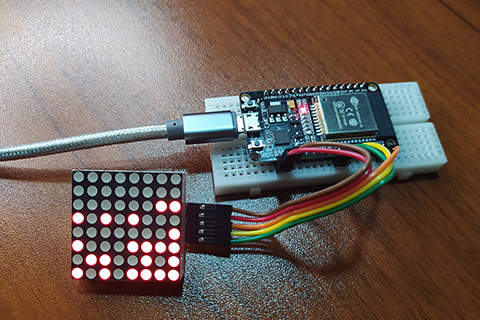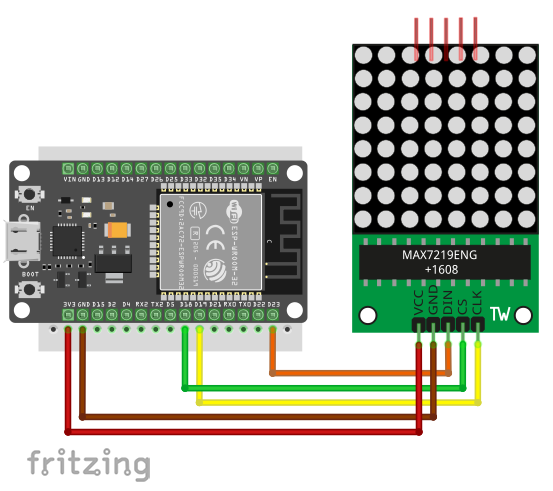023 – ESP32 MicroPython: Binary Clock

In this article, I would like to share to you on how to create this simple yet cool project using a single 8×8 dot matrix module to display a binary clock – a clock that is represented using binary numeric system.
BILL OF MATERIALS:
- An ESP32 development board (or any other development board with MicroPython firmware).
- An 8×8 Dot Matrix module with SPI interface (if you have I2C interface, you just need to use a different driver library and modify the source code a little bit).
- And some jumper wires.
HARDWARE INSTRUCTION:
For the hardware part, it is very easy just follow the circuit diagram below which connects the dot matrix to ESP32 as follows:
- Dot matrix VCC to 3.3V.
- Dot matrix GND pin to ESP32 GND pin.
- Dot matrix DIN pin to ESP32 GPIO 23.
- Dot matrix CLK pin to ESP32 GPIO 19.
- Dot matrix CS pin to ESP32 GPIO 18.

SOFTWARE INSTRUCTION:
- Copy the max7219 from Jeff Brown github: https://github.com/jgbrown32/ESP8266_MAX7219 or you may copy it in the SOURCE CODE section below.
- And save it to ESP32 MicroPython device root directory by clicking the File menu and select Save As.
- Select MicroPython device and name it as max7219.py and click OK.
- Copy the example source code below. Please feel free to modify it to your liking.
- Enjoy.
VIDEO DEMONSTRATION:
CALL TO ACTION:
For any concern, write your message in the comment section.
You might also like to support my journey on Youtube by Subscribing. Click this to Subscribe to TechToTinker.
Thank you and have a good days ahead.
See you,
– George Bantique | tech.to.tinker@gbantiquegmail-com
SOURCE CODE:
1. Binary Clock:
# More details can be found in TechToTinker.blogspot.com
# George Bantique | tech.to.tinker@gmail.com
from machine import Pin, SPI
from micropython import const
import framebuf, utime
_DIGIT_0 = const(0x1)
_DECODE_MODE = const(0x9)
_NO_DECODE = const(0x0)
_INTENSITY = const(0xa)
_INTENSITY_MIN = const(0x0)
_SCAN_LIMIT = const(0xb)
_DISPLAY_ALL_DIGITS = const(0x7)
_SHUTDOWN = const(0xc)
_SHUTDOWN_MODE = const(0x0)
_NORMAL_OPERATION = const(0x1)
_DISPLAY_TEST = const(0xf)
_DISPLAY_TEST_NORMAL_OPERATION = const(0x0)
_MATRIX_SIZE = const(8)
# _SCROLL_SPEED_NORMAL is ms to delay (slow) scrolling text.
_SCROLL_SPEED_NORMAL = 100
class Max7219(framebuf.FrameBuffer):
"""
Driver for MAX7219 8x8 LED matrices
https://github.com/vrialland/micropython-max7219
Example for ESP8266 with 2x4 matrices (one on top, one on bottom),
so we have a 32x16 display area:
>>> from machine import Pin, SPI
>>> from max7219 import Max7219
>>> spi = SPI(1, baudrate=10000000)
>>> screen = Max7219(32, 16, spi, Pin(15))
>>> screen.rect(0, 0, 32, 16, 1) # Draws a frame
>>> screen.text('Hi!', 4, 4, 1)
>>> screen.show()
On some matrices, the display is inverted (rotated 180°), in this case
you can use `rotate_180=True` in the class constructor.
"""
def __init__(self, width, height, spi, cs, rotate_180=False):
# Pins setup
self.spi = spi
self.cs = cs
self.cs.init(Pin.OUT, True)
# Dimensions
self.width = width
self.height = height
# Guess matrices disposition
self.cols = width // _MATRIX_SIZE
self.rows = height // _MATRIX_SIZE
self.nb_matrices = self.cols * self.rows
self.rotate_180 = rotate_180
# 1 bit per pixel (on / off) -> 8 bytes per matrix
self.buffer = bytearray(width * height // 8)
format = framebuf.MONO_HLSB if not self.rotate_180 else framebuf.MONO_HMSB
super().__init__(self.buffer, width, height, format)
# Init display
self.init_display()
def _write_command(self, command, data):
"""Write command on SPI"""
cmd = bytearray([command, data])
self.cs(0)
for matrix in range(self.nb_matrices):
self.spi.write(cmd)
self.cs(1)
def init_display(self):
"""Init hardware"""
for command, data in (
(_SHUTDOWN, _SHUTDOWN_MODE), # Prevent flash during init
(_DECODE_MODE, _NO_DECODE),
(_DISPLAY_TEST, _DISPLAY_TEST_NORMAL_OPERATION),
(_INTENSITY, _INTENSITY_MIN),
(_SCAN_LIMIT, _DISPLAY_ALL_DIGITS),
(_SHUTDOWN, _NORMAL_OPERATION), # Let's go
):
self._write_command(command, data)
self.fill(0)
self.show()
def brightness(self, value):
# Set display brightness (0 to 15)
if not 0 <= value < 16:
raise ValueError('Brightness must be between 0 and 15')
self._write_command(_INTENSITY, value)
def marquee(self, message):
start = 33
extent = 0 - (len(message) * 8) - 32
for i in range(start, extent, -1):
self.fill(0)
self.text(message, i, 0, 1)
self.show()
utime.sleep_ms(_SCROLL_SPEED_NORMAL)
def show(self):
"""Update display"""
# Write line per line on the matrices
for line in range(8):
self.cs(0)
for matrix in range(self.nb_matrices):
# Guess where the matrix is placed
row, col = divmod(matrix, self.cols)
# Compute where the data starts
if not self.rotate_180:
offset = row * 8 * self.cols
index = col + line * self.cols + offset
else:
offset = 8 * self.cols - row * (8 - line) * self.cols
index = (7 - line) * self.cols + col - offset
self.spi.write(bytearray([_DIGIT_0 + line, self.buffer[index]]))
self.cs(1)
2. max7219.py driver library:
# Jeff Brown max7219 driver library
from machine import Pin, SPI
from micropython import const
import framebuf, utime
_DIGIT_0 = const(0x1)
_DECODE_MODE = const(0x9)
_NO_DECODE = const(0x0)
_INTENSITY = const(0xa)
_INTENSITY_MIN = const(0x0)
_SCAN_LIMIT = const(0xb)
_DISPLAY_ALL_DIGITS = const(0x7)
_SHUTDOWN = const(0xc)
_SHUTDOWN_MODE = const(0x0)
_NORMAL_OPERATION = const(0x1)
_DISPLAY_TEST = const(0xf)
_DISPLAY_TEST_NORMAL_OPERATION = const(0x0)
_MATRIX_SIZE = const(8)
# _SCROLL_SPEED_NORMAL is ms to delay (slow) scrolling text.
_SCROLL_SPEED_NORMAL = 100
class Max7219(framebuf.FrameBuffer):
"""
Driver for MAX7219 8x8 LED matrices
https://github.com/vrialland/micropython-max7219
Example for ESP8266 with 2x4 matrices (one on top, one on bottom),
so we have a 32x16 display area:
>>> from machine import Pin, SPI
>>> from max7219 import Max7219
>>> spi = SPI(1, baudrate=10000000)
>>> screen = Max7219(32, 16, spi, Pin(15))
>>> screen.rect(0, 0, 32, 16, 1) # Draws a frame
>>> screen.text('Hi!', 4, 4, 1)
>>> screen.show()
On some matrices, the display is inverted (rotated 180°), in this case
you can use `rotate_180=True` in the class constructor.
"""
def __init__(self, width, height, spi, cs, rotate_180=False):
# Pins setup
self.spi = spi
self.cs = cs
self.cs.init(Pin.OUT, True)
# Dimensions
self.width = width
self.height = height
# Guess matrices disposition
self.cols = width // _MATRIX_SIZE
self.rows = height // _MATRIX_SIZE
self.nb_matrices = self.cols * self.rows
self.rotate_180 = rotate_180
# 1 bit per pixel (on / off) -> 8 bytes per matrix
self.buffer = bytearray(width * height // 8)
format = framebuf.MONO_HLSB if not self.rotate_180 else framebuf.MONO_HMSB
super().__init__(self.buffer, width, height, format)
# Init display
self.init_display()
def _write_command(self, command, data):
"""Write command on SPI"""
cmd = bytearray([command, data])
self.cs(0)
for matrix in range(self.nb_matrices):
self.spi.write(cmd)
self.cs(1)
def init_display(self):
"""Init hardware"""
for command, data in (
(_SHUTDOWN, _SHUTDOWN_MODE), # Prevent flash during init
(_DECODE_MODE, _NO_DECODE),
(_DISPLAY_TEST, _DISPLAY_TEST_NORMAL_OPERATION),
(_INTENSITY, _INTENSITY_MIN),
(_SCAN_LIMIT, _DISPLAY_ALL_DIGITS),
(_SHUTDOWN, _NORMAL_OPERATION), # Let's go
):
self._write_command(command, data)
self.fill(0)
self.show()
def brightness(self, value):
# Set display brightness (0 to 15)
if not 0 <= value < 16:
raise ValueError('Brightness must be between 0 and 15')
self._write_command(_INTENSITY, value)
def marquee(self, message):
start = 33
extent = 0 - (len(message) * 8) - 32
for i in range(start, extent, -1):
self.fill(0)
self.text(message, i, 0, 1)
self.show()
utime.sleep_ms(_SCROLL_SPEED_NORMAL)
def show(self):
"""Update display"""
# Write line per line on the matrices
for line in range(8):
self.cs(0)
for matrix in range(self.nb_matrices):
# Guess where the matrix is placed
row, col = divmod(matrix, self.cols)
# Compute where the data starts
if not self.rotate_180:
offset = row * 8 * self.cols
index = col + line * self.cols + offset
else:
offset = 8 * self.cols - row * (8 - line) * self.cols
index = (7 - line) * self.cols + col - offset
self.spi.write(bytearray([_DIGIT_0 + line, self.buffer[index]]))
self.cs(1)
REFERENCES AND CREDITS:
1. Jeff Brown max7219 library: https://github.com/jgbrown32/ESP8266_MAX7219








I AM STUDENT OF ELECTRONICS ENGINEERING I WANT HELP FOR MY PROJECT FIRE FIGHTER ROBOT YOU REPLY ME ASAP
THANK U email id- lambanaveen1999@gmail.com